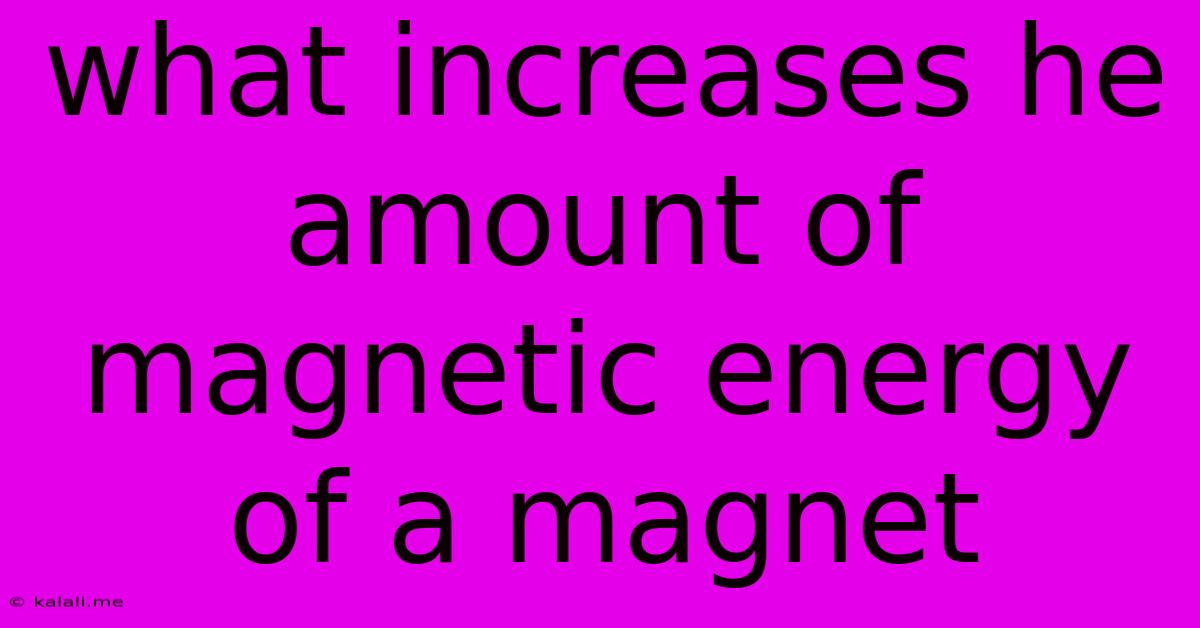What Increases He Amount Of Magnetic Energy Of A Magnet
Kalali
May 24, 2025 · 3 min read

Table of Contents
What Increases the Amount of Magnetic Energy of a Magnet?
Magnetic energy, the potential energy stored in a magnetic field, isn't something you simply "add" to a magnet. Instead, it's a property intrinsically linked to the magnet's strength and the configuration of its magnetic field. This article explores the factors that influence and ultimately determine the amount of magnetic energy a magnet possesses. Understanding these factors is crucial for anyone working with magnets, from researchers to hobbyists.
The Fundamental Relationship: Magnetic Field Strength and Energy
The energy stored in a magnetic field is directly related to its strength. A stronger magnetic field implies a greater amount of stored magnetic energy. This energy is proportional to the square of the magnetic field strength (B). The stronger the field (higher B), the exponentially greater the energy. This is a key concept to understand when considering how to increase a magnet's magnetic energy.
Factors Affecting a Magnet's Magnetic Energy
Several factors influence the strength of a magnet's magnetic field, and consequently, its magnetic energy:
-
Material Composition: The material a magnet is made from is paramount. Rare-earth magnets, such as neodymium (NdFeB), samarium cobalt (SmCo), and alnico magnets, exhibit significantly higher magnetic energy densities compared to ferrite or ceramic magnets. The specific alloy composition within each rare-earth category also influences its magnetic properties. Higher-grade neodymium magnets, for instance, will store more magnetic energy than lower-grade ones. The inherent magnetic properties of the material are directly related to its atomic structure and electron spin alignment.
-
Magnet Size and Shape: Larger magnets generally possess more magnetic energy because they have a larger volume over which the magnetic field is generated. The shape also plays a crucial role. A long, thin magnet will have a different field distribution and, therefore, different energy storage capabilities compared to a short, thick magnet. The design and geometry of the magnet significantly impact field homogeneity and overall energy. Specific shapes are optimized for specific applications.
-
Magnetization Process: The process used to magnetize the material profoundly affects the final magnetic strength. A more powerful magnetization process results in a more strongly magnetized magnet with higher stored energy. This process often involves exposing the material to a strong external magnetic field, and the efficacy depends on the equipment and techniques used. Improper magnetization can lead to uneven field distribution and reduced overall energy.
-
Temperature: Temperature significantly affects a magnet's magnetic properties. Most magnets exhibit a decrease in magnetization with increasing temperature. This is known as the Curie temperature – the temperature above which a ferromagnetic material loses its permanent magnetism. Operating a magnet near its Curie temperature drastically reduces its magnetic energy.
-
External Magnetic Fields: The presence of external magnetic fields can either enhance or diminish a magnet's magnetic field, consequently affecting its energy storage. A strong external field aligned with the magnet's field will temporarily enhance the overall magnetic field, resulting in increased energy. However, an opposing field can weaken the magnet.
Maximizing Magnetic Energy: Practical Considerations
To maximize the magnetic energy of a magnet, one needs to consider all of the factors outlined above. Selecting a magnet made from a high-energy material like neodymium is crucial. Optimizing the size and shape of the magnet for the intended application is also essential. Furthermore, ensuring proper magnetization using suitable equipment is critical. Finally, maintaining the magnet's operating temperature below its Curie point is fundamental to preserving its magnetic energy.
This comprehensive understanding of the contributing factors empowers users to effectively select and utilize magnets to optimize performance in diverse applications, from simple holding mechanisms to complex scientific instruments. The key takeaway is that the amount of magnetic energy is not a fixed quantity but rather a result of careful selection and optimal use of various interacting factors.
Latest Posts
Latest Posts
-
Dumber Than A Bag Of Hammers
May 24, 2025
-
Car Knocking When Turning Full Lock
May 24, 2025
-
Sherry Vinegar Vs Sherry Wine Vinegar
May 24, 2025
-
Alternative To Vinyl Straps On Patio Furniture
May 24, 2025
-
If Ifs And Buts Were Candies And Nuts
May 24, 2025
Related Post
Thank you for visiting our website which covers about What Increases He Amount Of Magnetic Energy Of A Magnet . We hope the information provided has been useful to you. Feel free to contact us if you have any questions or need further assistance. See you next time and don't miss to bookmark.